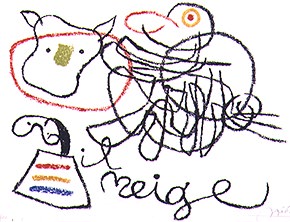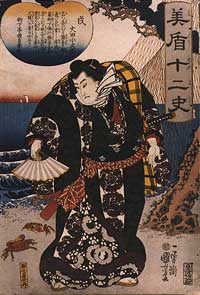
ANIMALS & PEOPLE
The relationship of people and animals is a common artistic theme. The pictures below portray both domestic and wild animals in some form of interaction with humans. Each illustrates different artistic styles and mediums (materials used to create the image). If you want to learn about these pictures and their artists, continue reading!
Activity: Write a story about your favorite picture on this page. Make sure you use your imagination!

| Fig. 1. Eduardo Chavez, "Longhorn Trail," 1939, Egg tempera on panel, 64 inches x 24 3/4 inches |
This painting by 20th century American artist Eduardo Chavez was an entry in a competition conducted in 1938 by the U.S. Federal Government. The winner was to be commissioned (employed) to create a group of murals for the U.S. Post Office in Amarillo, Texas. The entries all had to be the same size and proportions, and had to illustrate a theme relating to the history and development of the area. While Chavez' entry did not win the commission, it stands as an excellent example of the sort of art that was called for in government commissions of the Depression period during the 1930s, and was undoubtedly a very strong contender. Why? Because of his creative composition.
Notice how the slight variations in head poses and horn configurations lend variety to what could have been a somewhat uninteresting composition - a sea of bodies in profile along a narrow horizontal band.
Other items of note which add visual interest include the prominently different colored horse, the calf in the foreground, and the prairie dog hole and poised prairie dog at the bottom about a quarter of the way from the right of the picture.
The abstracted (not real-looking) forms and cubist color scheme make this sixty year-old painting seem "modern."

| Fig. 2. Joan Miro (1893-1983) "Ubu Aux Baleares," 1971, Color Lithograph, 19 1/2 inches x 25 inches |
Joan Miro was one of three artists of worldwide importance born in Catalonia, Spain. Miro helped shape the art of this century. The other two great artists were Pablo Picasso (1881-1973) and Salvador Dali (1904-1989). Miro was associated, like Dali, with the Surrealist movement, but their work is not at all alike.
Miro was sometimes inspired by objects he set up, sometimes by other paintings, landscape, or his own imagination. His works developed by freely drawing a series of lines without any conscious thought of what they were or might become. The Surrealists' aim was to help people get in touch with a different level of reality - sort of a fantasy vision. Miro's free flowing images provide the most direct visual connection with the paintings of the Abstract Expressionists such as Jackson Pollock.
"Ubu," the abstracted form above, was the most famous character created by Alfred Jarry, an eccentric French author and dramatist of the late 19th century who was a big influence on the Surrealists. Ubu was a monstrous figure who represents human evils and rebellion. In this picture Ubu is lingering in the Baleares Islands with a couple of hard to identify, but typically Miro-like, animals.
Like some United States currency (money), but with a somewhat different emphasis, much Italian currency uses imagery of the Roman Republic and the Empire. The banknote above depicts a she-wolf and the legendary founders of Rome, Romulus and Remus The she-wolf was made in Etruria (pre-Roman Italy) in about 500 B.C. The small infant figures, done in a different style, were added approximately 1,000 years later, during the Renaissance.
Romulus and Remus were, according to legend, abandoned as babies and suckled by a she-wolf. The figure of the she-wolf was housed in the Roman Senate at the height of the Empire. The use of the animal form in this case is an attempt to associate the latter-day currency with the power and stability of the Roman Empire without reminding one of its eventual collapse.

| Fig. 3. Artist unknown,"50 lire banknote with Capitoline She-Wolf," 20th century, engraving on paper currency, Italy |

| Fig. 4. Edwin Lanseer,"Two dollar bill," 19th century, engraving on paper currency, England |
Edwin Landseer was one of the best-known and -loved animal painters of all time. By putting images of faithfulness, warmth and usefulness (the milk cows) on this banknote, the Somerset Worcester Savings Bank hopes to siphon off the sentiment and goodwill that Landseer's images suggest to the viewer.
In our own time, advertising attempts this technique quite often. How many commercials have you seen that try to give the impression that fast food restaurants, insurance companies or department stores are somehow to be regarded as "old fashioned, ""neighborly, " and "caring?"
Kuniyoshi was a leading artist and designer of wood block prints during the Edo period in Japan. This era came to an end shortly after the artist's death, when Japan was forced to open its doors to the outside world. The Edo period was a time of strictly enforced class separation. This meant that the merchant class, which had most of the money but no political power, was forbidden to spend their money as they pleased. Under these circumstances, a tremendous amount of money was spent on various types of entertainment and pleasures. These were often illustrated as scenes from what was called the "floating world," or ukiyo-e, a term often applied to this sort of print. Ukiyo-e was later enormously influential on the Impressionists and the entire development of modern art in Europe.
The print above is a satire of Japan's national sport, sumo wrestling. In this scene, a sumo wrestler, in full ceremonial robes, is refereeing a match between the two crabs in the lower left corner. Since Japan is an island nation, sea creatures appear more often in the country's art than would be the case in a more landlocked country.
The flat and graded transparent colors, the strongly outlined forms, the decorative patterns and the writing contained in cartouches (similar to Egyptian hieroglyphs) were all instrumental in changing the way that many artists looked at their work. This style made strong contributions to the whole idea of the "picture" changing from a window with a frame around it to an independent object with its own internal logic and "reality. "

| Fig. 5. Kuniyoshi (1797-1861),"Sumo with robe and crabs at lower left" 19th century, wood block print, multicolored, vertical, Japan |

| Fig. 6. Jean Frederic Schall,"Madam Dugazon" c. 1730, oil on canvas, 13 inches x 10 inches, France |




